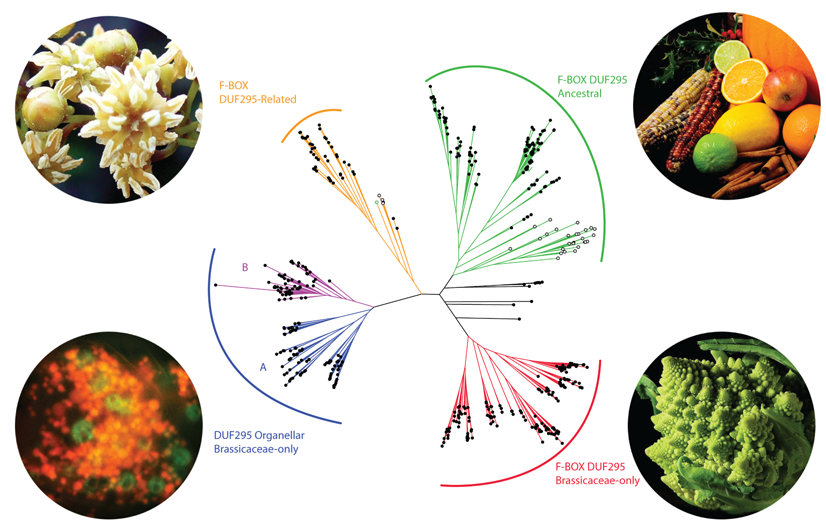博文
Molecular Biology and Evolution:植物线粒体蛋白新功能化
||
Neofunctionalization of Mitochondrial Proteins and Incorporation into Signaling Networks in Plants
First author: Sbatie Lama; Affiliations: Lund University (隆德大学): Lund, Sweden
Corresponding author: Olivier Van Aken
Because of their symbiotic origin, many mitochondrial proteins are well conserved across eukaryotic kingdoms. It is however less obvious how specific lineages have obtained novel nuclear-encoded mitochondrial proteins. Here, we report a case of mitochondrial neofunctionalization in plants. Phylogenetic analysis of genes containing the Domain of Unknown Function 295 (DUF295) revealed that the domain likely originated in Angiosperms. The C-terminal DUF295 domain is usually accompanied by an N-terminal F-box domain, involved in ubiquitin ligation via binding with ASK1/SKP1-type proteins. Due to gene duplication, the gene family has expanded rapidly, with 94 DUF295-related genes in Arabidopsis thaliana alone. Two DUF295 family subgroups have uniquely evolved and quickly expanded within Brassicaceae. One of these subgroups has completely lost the F-box, but instead obtained strongly predicted mitochondrial targeting peptides. We show that several representatives of this DUF295 Organellar group are effectively targeted to plant mitochondria and chloroplasts. Furthermore, many DUF295 Organellar genes are induced by mitochondrial dysfunction, whereas F-Box DUF295 genes are not. In agreement, several Brassicaceae-specific DUF295 Organellar genes were incorporated in the evolutionary much older ANAC017-dependent mitochondrial retrograde signaling pathway. Finally, a representative set of DUF295 T-DNA insertion mutants was created. No obvious aberrant phenotypes during normal growth and mitochondrial dysfunction were observed, most likely due to the large extent of gene duplication and redundancy. Overall, this study provides insight into how novel mitochondrial proteins can be created via “intercompartmental” gene duplication events. Moreover, our analysis shows that these newly evolved genes can then be specifically integrated into relevant, pre-existing coexpression networks.
由于线粒体是共生起源,所以在整个真核生物中很多线粒体蛋白是非常保守的。然而,特定支系如何获得新的由核编码的线粒体蛋白还不太清楚。本文,作者报道了一个植物线粒体新功能化的案例。对包含DUF295结构域的基因的系统发育分析显示该结构域很可能起源于被子植物。DUF295结构域的C端通常会有一个N端F-box结构域,而F-box结构域通过结合ASK1/SKP1类蛋白参与泛素连接。由于基因复制事件,该基因家族扩张得十分迅速,在拟南芥基因组中大概有94个DUF295相关基因。十字花科演化出了两个特有的DUF295亚家族,并且这两个DUF295亚家族扩张十分迅速。其中一个亚家族完全丢失了F-box结构域,但是获得了线粒体靶向肽。作者的研究显示这个亚家族(DUF295 Organellargroup)的某些成员能够有效靶向植物的线粒体和叶绿体。此外,许多Organellar基因的表达受到线粒体功能紊乱的诱导,而具有F-box结构域的DUF295基因则不会。与此同时,一些十字花科特异的Organellar基因被整合到了演化上更加古老的、ANAC017依赖型线粒体逆行信号通路中。最终,作者构建了一系列的DUF295 T-DNA插入突变体。作者在突变体正常生长或线粒体功能紊乱过程中并未观察到明显的异常表型,这可能是由于该类基因家族比较庞大,存在严重的功能冗余。综上,本文的研究为植物基因组内部通过基因复制事件创造出线粒体蛋白提供了新的视野。同时,本文的研究显示这些新演化出的基因可以被特异性地整合到相关的、已存在的共表达网络中。
通讯:Olivier Van Aken(https://www.biology.lu.se/olivier-van-aken)
研究方向:响应于环境胁迫调控基因表达的信号转导网络。
doi: https://doi.org/10.1093/molbev/msz031
Journal: Molecular Biology and Evolution
Published date: February 19, 2019
https://blog.sciencenet.cn/blog-3158122-1179977.html
上一篇:Science Advance:拟南芥R环“读取”蛋白
下一篇:New Phytologist:植物侧生器官发育的分子调控机制
全部作者的其他最新博文
- • Plant Physiology:CsMADS3促进柑果中的叶绿素降解和类胡萝卜素合成(华中农业大学)
- • Molecular Plant:LBD11-ROS反馈调节作用于拟南芥的维管形成层增殖和次生生长(浦项科技大学)
- • Science Advances:根结线虫通过调控植物的CLE3-CLV1模块,促进侵染进程(日本熊本大学)
- • Nature Communications:油菜素内酯参与植物营养生长期转变的分子机制解析(浙江农林大学)
- • Current Biology:光合作用产生的蔗糖驱动侧根“生物钟”(德国弗莱堡大学)
- • PNAS:花同源异型基因在叶中被抑制、花中被激活的分子机制(南卡罗来纳大学)

